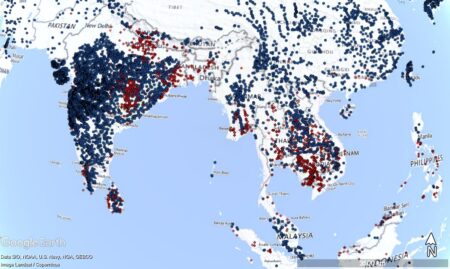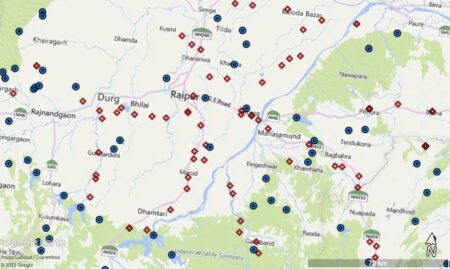- One hundred important questions facing plant science: an international perspective. How do we leverage existing genetic diversity to create climate-resilient crops? is only number 3 you say? I’ll take it. And in fact that broad question gets deconstructed in questions 36-71. Now, let’s see how today’s haul of papers relates to that, shall we?
- A strategy for the next decade to address data deficiency in neglected biodiversity. Well, yeah, easy one, clearly you need data to conserve the crop wild relatives that could help you breed those climate-resilient crops.
- Post-2020 biodiversity framework challenged by cropland expansion in protected areas. Apart from anything else, that data would tell you which CWR in protected areas are threatened with cropland expansion, and said CWR could help you with breeding crops that could limit cropland expansion by increasing production on existing cropland. Could, could, could…
- Global Maps of Agricultural Expansion Potential at a 300 m Resolution. That cropland expansion might do less damage in some places than others. Still with me?
- Increased probability of hot and dry weather extremes during the growing season threatens global crop yields. Right, that’s why those CWR might come in useful. Assuming you can still find them with all that cropland expansion.
- Divergent impacts of crop diversity on caloric and economic yield stability. At the state level within the USA, crop species diversity is positively associated with yield stability when yield is measured in $ but negatively when measured in calories. Now do it for genetic diversity.
- Role of staple cereals in human nutrition: Separating the wheat from the chaff in the infodemics age. The benefits of those climate-resilient, more nutritious crops need to be better communicated.
- Simple solutions for complex problems? What is missing in agriculture for nutrition interventions. What does nutritious mean anyway?
- “Whose demand?” The co-construction of markets, demand and gender in development-oriented crop breeding. Who is it that wants those climate-resilient, nutritious crops anyway?
- Take-home message: leveraging existing genetic diversity to create climate-resilient crops might be the easy part.
Brainfood: Traits & environment, Acacia growth, Local extinction risk, Lebanese CWR priorities, Malawi CWR payments, Bread wheat origins, Wild lettuce, Ethiopian forages, Editing forages
- Why can’t we predict traits from the environment? Because plants are not collections of independent, isolated traits. All the more reason to study, understand and protect wild plants of economic importance, as the following papers show.
- Differential climatic conditions drive growth of Acacia tortilis tree in its range edges in Africa and Asia. Case in point of the above. Makes germplasm evaluation really hard.
- Understanding local plant extinctions before it is too late: bridging evolutionary genomics with global ecology. Modelling based on the genomic offset (GO) method and the mutations–area relationship (MAR) can help better predict the risk of extinction of different populations.
- Crop wild relatives in Lebanon: mapping the distribution of Poaceae and Fabaceae priority taxa for conservation planning. Bekaa and Baalbak have the highest diversity and the SW the most gaps.
- Community-Level Incentive Mechanisms for the Conservation of Crop Wild Relatives: A Malawi Case Study. Paying communities to conserve crop wild relatives could work and be relatively cheap. Waiting to see this being applied in the Bekaa.
- Population genomics unravels the Holocene history of bread wheat and its relatives. Yeah but crop wild relatives really held back bread wheat domestication. So maybe the Bekaa owes everyone else.
- New insights gained from collections of wild Lactuca relatives in the gene bank of the Institute of Evolution, University of Haifa. Maybe they can gain an insight into how to make lettuce taste of something. And I wonder what environmental variable that will be associated with.
- Climate change and land-use change impacts on future availability of forage grass species for Ethiopian dairy systems. Two forages will do better under climate change, one worse. Assuming a lot of stuff.
- Application of CRISPR/Cas9 technology in forages. But plants are not collections of independent, isolated traits, right?
Dams, damn dams, and accessions
Every once in a while a new dam dataset crops up. Dam, not damn. Well, maybe damn as well. Anyway, when that happens, I feel compelled to mash it up with accession locality data. Because if I don’t do it, who will?
The new dataset is the Global Dam Tracker, and you can download it and everything of course. It’s pretty easy to then upload it to Google Earth and play around with it. Including combining it with data on wild Oryza accessions from Genesys, for example.
On this map, the dams are shown in blue and wild rice accessions in red.
You can zoom in if you’re worried about the long-term in situ future of any given population.
Not for the first time, I wonder about the feasibility of one day automatically and in real time combining data from multiple potential stressors, including dams, to predict the risk of genetic erosion around the world. Something that AI should be able to do, surely?
Nibbles: CIAT, AGG, Volcani, Restoration, Food diversity, Deforestation, Berries, Diverse systems
- I’ve been told I need to be more explicit in my Nibbling. So here’s a CCTV video on the Future Seeds genebank in Colombia. You know the one.
- The Australian Grains Genebank (AGG) in Horsham is announcing a new online seed catalogue. The genebank is also on Genesys.
- According to this article, the Israel Plant Gene Bank of the Volcani Center Agricultural Research Organization near Tel Aviv has some pretty cool wheats. I wonder if any of them are also in the AGG. The Volcani genebank is not on Genesys, alas. But some of its material is.
- The Director of Science of the Royal Botanic Gardens, Kew and others say that we need lots more genebanks if we are to do all the ecosystem restoration that needs to be done around the world.
- Short & sweet blog post on the importance of food diversity from the policy officer at the Soil Association. Genebanks not mentioned though, alas.
- Vox has an article on a new European law aimed at preventing the sale of some agricultural commodities grown on recently cleared forest land. I guess the next step would be restoring those ecosystems. If only there were more genebanks…
- Some hero mapped the distribution of all the berries of North America, and made cool videos of the results.
- Report from Wageningen AU on “The need to enhance crop, livestock andaquatic genetic diversity in food systems.” Lots and lots on genebanks.
- So, what did you think? Do you prefer telegraphic, impressionistic Nibbles, or these lengthier, more explicit versions? Let me know in the comments.
Liberating seeds — and climate matching tools
I hit “publish” too soon yesterday. If I had waited a couple of hours, I could have done a deeper dive into how Jeremy spent his holidays, by adding his just-dropped podcast on the “Let’s Liberate Diversity” Forum held in Budapest back in October to his last newsletter of 2022.
In the podcast, Jeremy muses on the new EU Organic Regulation (Regulation (EU) 2018/848), which finally allows the marketing of organic heterogeneous material (OHM), and interviews two beneficiaries of this welcome change in the law. Spoiler alert: Belgian beer is being re-Belgianized, and everybody seems very happy about it.
Incidentally, if you’re interested in doing the kind of climate matching Jeremy mentions in his third note, you could check out this website, though it only covers Europe. If you want global coverage, you might have to brush up on your R. 1

